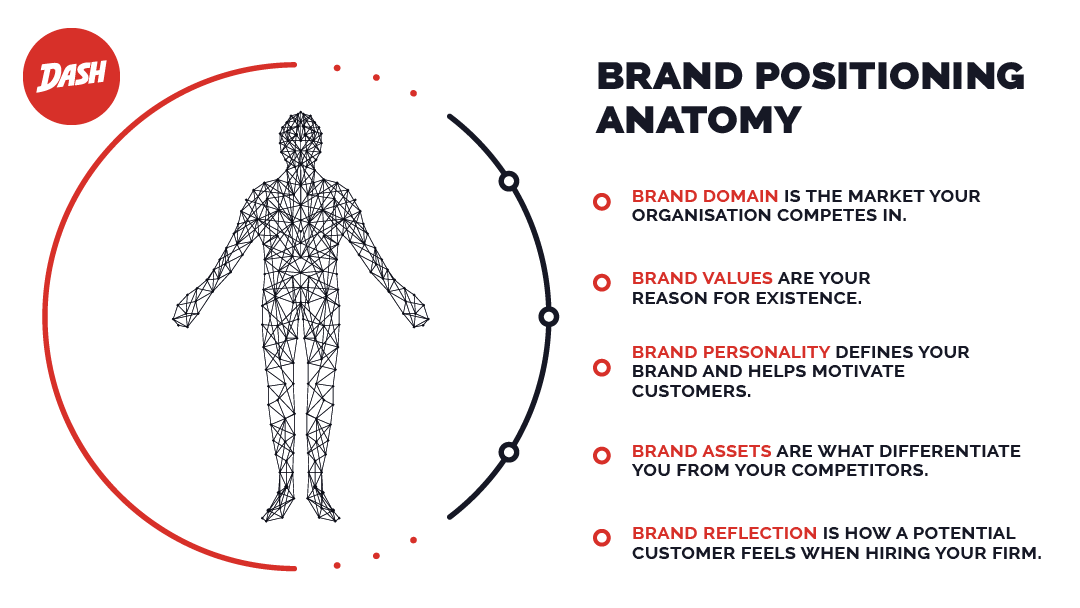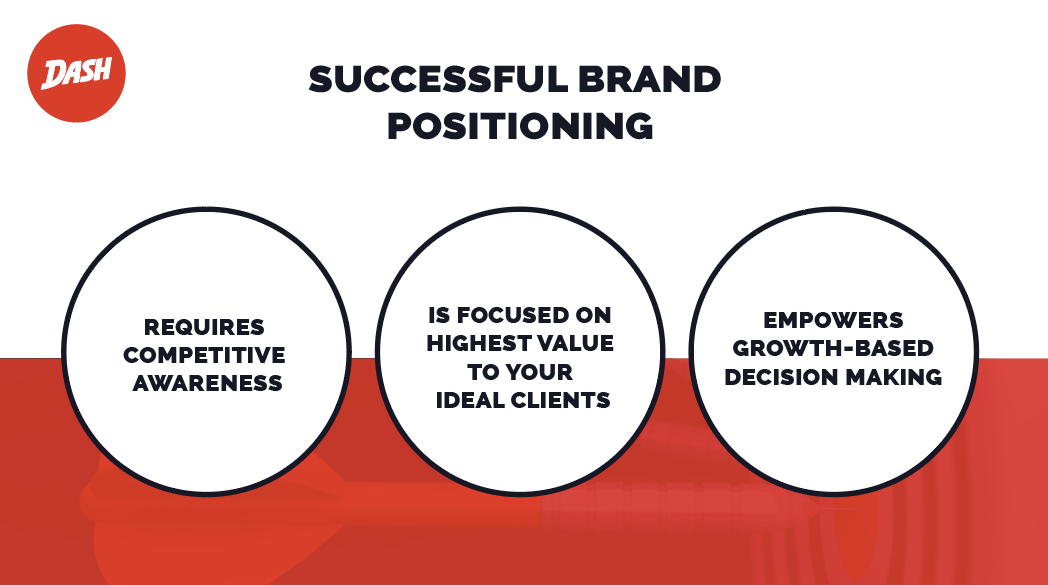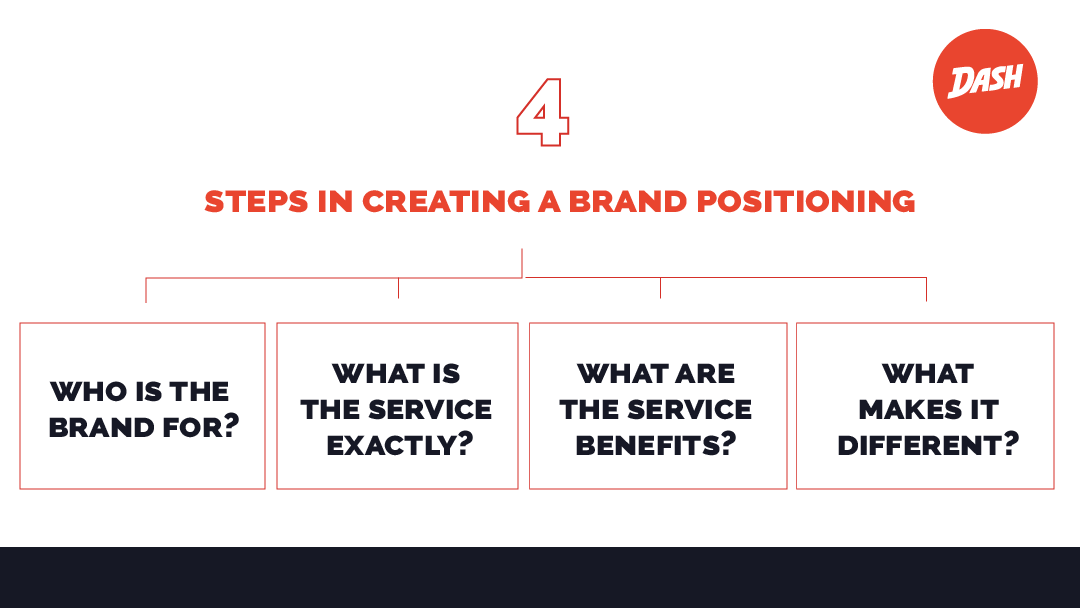Some would call it a radical idea, but it’s the foundation of proper branding: not everyone is your customer, nor should they be. Professional service organizations that adopt this branding tenet can quickly learn who their real customers are and successfully market to them. As brands who consistently present themselves see an average revenue increase of 33 percent, brand positioning not only communicates your organizations unique value, it fuels growth and strengthens its bottom line.

What is Brand Positioning?
The concept of brand positioning dates back to the 80s. In 1981, Jack Trout and Al Ries, two Madison Avenue ad executives, wrote a little book entitled “Positioning: The Battle for Your Mind.” In it, they built a case for establishing key features or benefits a business offered that would, through advertising, become closely associated with how potential customers viewed the company. Around the same time, advertisers began to see the merit in companies and brands narrowing their targeted market focus and using PR techniques to build brand recognition and loyalty.
The most common definition of brand positioning is the “space” your company owns in a customer’s mind. From service organizations to retailers, manufacturers, and non-profits, brand positioning works to make what you offer instantly recognizable to those who would benefit by working with your business. One thing is clear: no organization can truly thrive in its market without an established brand position.

Implementing a brand position begins with creating a brand statement that describes who your target market is and how you’d like to see your brand perceived by customers. We dive into brand statements a little later in this piece.
The Anatomy of a Brand
Just like human anatomy, branding is a complex process made up of different essential parts. Each of these parts works in tandem with the others to create a living entity—your brand—that is like no other.:
- Brand domain is the market your organization competes in.
- Brand values are your reason for existence.
- Brand personality defines your brand and helps motivate customers.
- Brand assets are what differentiate you from your competitors.
- Brand reflection is how a potential customer feels when hiring your firm.
When you start to think of your organization as a “person” with its unique look, style, and personality, you can begin to mold into existence an entity the right people flock to for advice and solutions.

Why is Brand Positioning Important?
With 80 percent of brand marketers saying they’re concerned about creating engaging brand experiences and 77 percent of B2B marketers convinced branding is critical to growth, it’s clear to see just how vital brand position can be to your organization’s success.
Every professional service provider knows how important branding is to building business image and value. When you have the right brand position, it can help you create useful marketing messages, shape services, and structure pricing. A solid brand position:
- Sets you apart from the competition.
- Helps you focus on a specific target market.
- Drives further services development.
- Fuels more creative decision-making.
- Provides tools to win more clients.
Done right, positioning has the power to turn your professional services organization into a potent marketing force. It also gets you out of the tired, cliched way of thinking that the more prospects, the better.

Why Would a Firm Choose This Strategy?
No matter which professional services market you’re in, it’s bound to shift and progress as times and people change. Developing a brand positioning strategy not only prepares your firm for current market conditions but helps you reassess your approach down the road as needed.
The market changes, new competitors appear on the scene, and you—and they—develop new services. Maintaining the same positioning even though times and clients are evolving may mean your brand loses relevance. Successful brand positioning, then:
- Relies on consistently examining what the competition is doing.
- Provides relevant value to your customers and clients.
- Helps your organization make growth-based strategic decisions.
- Sets your brand apart as new market changes occur.

Creating a Brand Statement
When you hear the word “brand,” do you right away think of a logo? If so, you’re in good company. Many people equate well-known brands like Nike, Starbucks, and Apple with their logos. But while immediate recall of a logo is the sign of a strong brand, there’s much more to branding than a logo. That’s because behind every successful logo there’s a strategy that plays a crucial role in setting a brand apart.
A brand positioning statement is simply a one or two-sentence statement that communicates your brand’s unique value to your customers in relation to the competition. An important distinction to keep in mind is that a brand statement is not a tagline, which is created once you’ve crafted your brand statement.
There are four key steps in crafting a brand positioning statement:

- Who is it for? How can you quickly sum up who your target customer is?
- What is the service? What market or niche is your brand competing in and how are your services relevant to your target audience?
- How does your service help? What are the key benefits your services offer? What is the most compelling benefit you offer your target audience that your competitors do not?
- How is your service different? What differentiates your brand and what evidence can you provide to show you deliver on your promise?
Using these questions you can generally create a good positioning statement:

For [target audience], our [service] is the best way for them to [benefit]
because they can trust us to [reason to believe].
Here’s a real-life example. Back at the turn of the century Amazon, which at the time almost exclusively sold books, crafted this positioning statement:
“For World Wide Web users who enjoy books, Amazon.com is a retail bookseller that provides instant access to over 1.1 million books. Unlike traditional book retailers, Amazon.com provides a combination of extraordinary convenience, low prices, and comprehensive selection.”
Building a Brand Position
So, how do you build a brand position that showcases how awesome you are? What does it take to create a unique space for your professional services brand in your market? Which techniques will motivate your target audience to choose your brand, not your competitor’s?
Brands are built through activities such as competitive research and analysis, customer insights, and a clear-eyed evaluation of where your organization stands and fits in the marketplace. At the center of the brand-building process are your customers, who have an almost unlimited choice in who they want to work with. Rising above the competitive din and proving your services’ value takes a lot of effort but the reward of loyal customers who refer you to others is well worth it.

Brand positioning, though, is more than telling people why your organization is special. It means finding a way to emotionally connect with your target audience and selling them on your unique benefits. Positioning flows from:
- The pain points your services solve.
- How your services are the best solution.
- The exceptional experiences people have as a result of using your services.
In other words, your brand must establish an image, character, and reputation before a client buys into your services.
Are there proven ways to build a strong brand position? Yes. Once you identify your brand’s unique place in the market, there are seven key steps to creating a strong brand position:
- Determine how your brand is currently positioned.
- Identify the competition.
- Understand how competitors are positioning themselves.
- Compare your positioning to the competition and identify your unique offerings.
- Develop a distinct, value-based positioning strategy.
- Craft your brand positioning statement.
- Test the effectiveness and ROI of your positioning efforts.

Some find it easier to visualize the process by designing a brand positioning map where their brand’s strengths and weaknesses in relation to the competition are laid out. The map can help you identify market opportunities, recognize areas of competitive advantage, and predict where and when market shifts will occur.
To create a brand positioning map:
- Determine which of your services matter most to your target audience. The best way to do this? Use surveys to find out what their hot buttons are and how they rate your offerings with your competitors’.
- Graph the results for each separate service.
- Interpret whether how you’re positioning your brand reflects what your audience wants.
- Make positioning changes that elevate your brand above the rest.
No matter which service industry you’re in, brand positioning can be the difference between being a superstar or just another bit player in an overcrowded market. And what works for another organization won’t necessarily work for you. But as long as you keep the focus on who you want to reach, what you have to offer, and who you’re up against, you can develop a brand positioning strategy that not only finds your target audience but reels them in.

Frequently Asked Questions
What is the difference between brand positioning and product positioning?
For professional service organizations, it’s the difference between brand and service positioning, but the core explanation is the same. Service positioning is the process you use to communicate your services’ attributes to your target audience. Put another way, when you have a service to offer, you want to illustrate to potential clients why they should prefer to get that service from you. Brand positioning, on the other hand, is the conceptional place you want to own in your target audience’s mind; it’s the way potential clients think about your brand when determining which services they’ll invest in. So, service positioning is about creating a connection to a client’s needs; brand positioning is creating a relationship in a client’s mind with your brand.
What is a good example of strong positioning?
Tesla is a perfect example of how to brand your offering without factoring in price. The company’s branding focuses solely on the quality of its vehicles. It’s also been able to carve out a niche market by promoting itself through quirky ads and using CEO Elon Musk as the “eccentric” face of the brand.

How do you improve brand positioning?
The three top ways to begin improving your brand position are to know on a deep level who your target audience is, what your company’s capabilities are to deliver to your target audience, and understanding who you’re up against, i.e., the competition.
Are there different types of brand positioning?
Numbers vary, but for professional services organizations, the five most common positioning strategies include positioning based on:
- Service characteristics.
- Quality or luxury
- Service application
- Competition
- Price, though this is not generally a desirable way to differentiate your brand.




